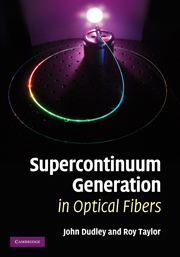Book contents
- Frontmatter
- Contents
- List of contributors
- Preface
- 1 Introduction and history
- 2 Supercontinuum generation in microstructure fibers – a historical note
- 3 Nonlinear fibre optics overview
- 4 Fibre supercontinuum generation overview
- 5 Silica fibres for supercontinuum generation
- 6 Supercontinuum generation and nonlinearity in soft glass fibres
- 7 Increasing the blue-shift of a picosecond pumped supercontinuum
- 8 Continuous wave supercontinuum generation
- 9 Theory of supercontinuum and interaction of solitons with dispersive waves
- 10 Interaction of four-wave mixing and stimulated Raman scattering in optical fibers
- 11 Nonlinear optics in emerging waveguides: revised fundamentals and implications
- 12 Supercontinuum generation in dispersion-varying fibers
- 13 Supercontinuum generation in chalcogenide glass waveguides
- 14 Supercontinuum generation for carrier-envelope phase stabilization of mode-locked lasers
- 15 Biophotonics applications of supercontinuum generation
- 16 Fiber sources of tailored supercontinuum in nonlinear microspectroscopy and imaging
- Index
11 - Nonlinear optics in emerging waveguides: revised fundamentals and implications
Published online by Cambridge University Press: 06 July 2010
- Frontmatter
- Contents
- List of contributors
- Preface
- 1 Introduction and history
- 2 Supercontinuum generation in microstructure fibers – a historical note
- 3 Nonlinear fibre optics overview
- 4 Fibre supercontinuum generation overview
- 5 Silica fibres for supercontinuum generation
- 6 Supercontinuum generation and nonlinearity in soft glass fibres
- 7 Increasing the blue-shift of a picosecond pumped supercontinuum
- 8 Continuous wave supercontinuum generation
- 9 Theory of supercontinuum and interaction of solitons with dispersive waves
- 10 Interaction of four-wave mixing and stimulated Raman scattering in optical fibers
- 11 Nonlinear optics in emerging waveguides: revised fundamentals and implications
- 12 Supercontinuum generation in dispersion-varying fibers
- 13 Supercontinuum generation in chalcogenide glass waveguides
- 14 Supercontinuum generation for carrier-envelope phase stabilization of mode-locked lasers
- 15 Biophotonics applications of supercontinuum generation
- 16 Fiber sources of tailored supercontinuum in nonlinear microspectroscopy and imaging
- Index
Summary
Introduction
Guided-wave nonlinear optics has attracted significant interest because of the unique environment that waveguides provide for nonlinear interactions, including tight confinement (high intensity), long interaction lengths (especially for fibres), control of propagation constants, and the possibility to incorporate them with integrated circuits (mainly for planar waveguides) [see (Lin et al., 2007; Knight and Skryabin, 2007; Foster et al., 2008; Afshar and Monro, 2009) and references therein]. Recent and rapid progress in design and manufacturing of complex structured microstructured optical fibres and planar waveguides with subwavelength features (including both subwavelength inclusions and voids) has further extended the opportunities to develop nonlinear devices by enabling extreme nonlinearity to combine with tailorable chromatic dispersion (Lin et al., 2007; Knight and Skryabin, 2007; Foster et al., 2008; Koos et al., 2007).
The nonlinear optical phenomena that occur in waveguides are determined through two main factors; the linear and nonlinear properties of the constituent bulk materials, and the optical properties of the waveguide. Recent advances in the design and fabrication of complex structured waveguides with high contrast linear refractive indices, inhomogeneous cross-sections, and subwavelength features have provided great potential to accelerate the field of guided-wave nonlinear optics. We define a new class of optical waveguides, “emerging waveguides”, as waveguides with a combination of the following features:
(i) High index materials
(ii) Inhomogeneous and complex structure
(iii) Subwavelength features such as voids or material inclusions.
- Type
- Chapter
- Information
- Supercontinuum Generation in Optical Fibers , pp. 226 - 284Publisher: Cambridge University PressPrint publication year: 2010

